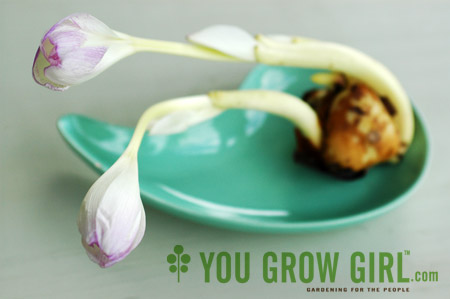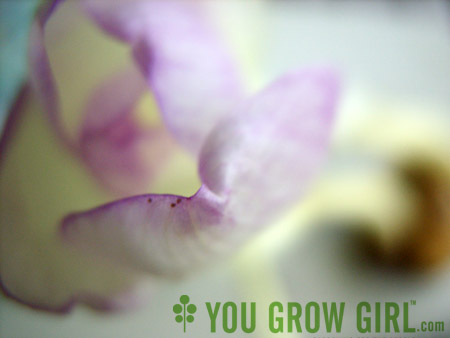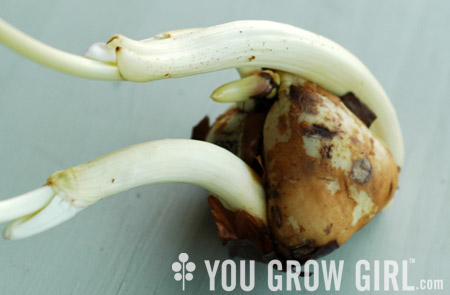
I spotted bags of Colchicums, a fall-blooming bulb plant that looks a lot like crocus, while perusing the bulb section of my local garden shop a few weeks back. I’ve long admired the delicate alien beauty of ‘Naked Ladies’, aptly named for their stark, bare petals poking up through the soil. But what caught my eye on that day was that the text on bags of individually packaged bulbs advertised setting the bulb on a bare windowsill (no water tray, no spritzing, no nothing) rather than planting in-ground as a unique, but temporary houseplant. I’m always up for an experiment so I bought one large corm to keep out of the ground, at least temporarily, to see what would happen.

About Colchicums
While colchicum flowers look a lot like over-sized crocuses they are in fact a member of the lily family and are not related to the crocus at all. This is an important distinction to keep in mind whether forcing on a windowsill or growing in the garden since the stigmas of a specific crocus species, Crocus sativa, are a valued culinary spice (saffron) while all parts of the colchicum are poisonous. That fact alone has made me suddenly paranoid about having both plants in the same garden. DON’T harvest the poison stigma! What makes these flowering corms (they aren’t technically bulbs) so unique and aesthetically peculiar is that while the plant produces leaves in the spring and through to midsummer, blooms do not emerge until the leaves have died back and dried up leaving naked flowers poking out through the soil in the fall when most other bulb plants have had their day in the sun.

Grow It
Colchicums are a no-brainer requiring very little fuss or muss in the garden. Provide a location that is bright and sunny with reasonably draining soil and ample water during the growing season and your plants will naturalize, self-propagating themselves in the coming years. Getting them to flower in the garden is as easy as cutting back the water and allowing a bit of dryness at the end of the summer just before the plant heads into dormancy.
Plant your bulbs in the late-summer/early fall, setting them deep in the ground with a good 4 inches head space. You can amend your soil before planting with a bit of grit, compost, or sand if your soil is on the clay side but colchicums are quite tolerant of a variety of conditions and will even put up with a bit of dappled shade if a bright and sunny spot is not available.
Come spring your colchicums will begin to send out shoots of foliage that will thrive in the garden until mid-summer, at which time they will begin to dry out and look rather bad. As with most bulbs allow the foliage to die back naturally, resisting the temptation to cut away and clean up ratty leaves. This stage is critical in nourishing the bulb so it can do the hard work of producing flowers and continuing next year’s cycle all over again.
Because colchicums readily naturalize making lots of new plants over the following years, there will come a time when things get a little bit too cozy and dividing is essential. Just dig them up, pull the corms apart where natural divisions occur, and replant at the same depth providing a few inches of breathing room between corms.
On Forcing
Having poured through countless resources related to Colchicums the conclusion is always the same; forcing the corm depletes the plant’s energy so much you might as well just toss it away like a snotty tissue (ever heard of handkerchiefs?) once it’s done its business. “Might as well” my ass. Throw away five bucks without giving it the old college try? No way!
Here’s why I think replanting could actually work: Colchicum corms are so easy to flower it’s not uncommon to find piles of them blooming right in the box at the nursery. Since windowsill forcing is akin to forgetting them in the box (for about half a second) then why not try popping it in the ground as soon as it is done blooming to see what happens? I’d hardly call doing nothing and watching a plant bloom “forcing.” In my experience, forgotten or forced bulbs that are still plump and fungus-free do not produce well in the first and sometimes the second year but they do flower, eventually. Sure you’re not getting that spectacular show right away, but so what? I’d much rather see my five bucks amount to something a year or two from now than not at all.
oh my goodness! i finally now know what the sqeeky green leaves are that keep popping up in the summer, don’t bloom, then turn brown and die! I thought it was dwarf skunk cabbage that magically grew in full sun. I had no idea that the foliage and the fall crocus-like-flower were the same plant. that’s so cool! thanks for being such a fountain of info!!!
Oh good! I can see the skunk cabbage resemblance…. and yeah… what else blooms AFTER the leaves are gone.
I like the way you think. I will not give up on a plant and even if it takes awhile, it is worth the wait when it finally blooms or grow. I brought a colchicum and my granddaughter got a whole of it and broke two little starters off of it. I planted it in the ground and I am looking forward to it blooming. The waiting and the finally appearance is sooo exciting!!!
I like your passion, I’m always at awe with people who could create something with their bare hands, my grandmother is a good gardener, I just wish I was able to inherit that… I would like to know what happened to your colchicum and whether you were able to revive it after re-planting :)
I was looking for information on what time of year to plant peppers and if you can plant them from the seed inside?